Archive for February, 2011
Saturday, February 19th, 2011
‘The Getting of Wisdom‘ is a well-known Australian novel published in 1910 by Australian novelist Henry Handel Richardson [a pen name for Ethel Florence Lindsay Richardson]. According to Wikipedia, Richardson was a writer born into wealth in 1870, but who fell on hard times. The novel is based on this life changing experience, social expectations, coping with social shame and the destruction of innocence.
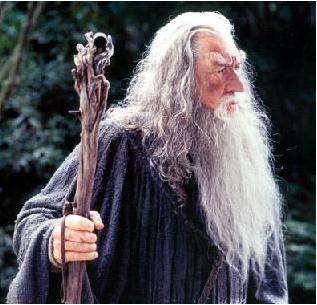 Gandalf, The Lord of the Rings Gandalf, The Lord of the Rings
.
Vice-chancellor of Macquarie University, Steven Schwartz, picked up on this theme in a recent article published in the Sydney Morning Herald on 8th February 2010, entitled: ‘Training is easy, not so the getting of wisdom‘
The article is reproduced as follows:
‘Julie Lloyd is 59. With her grey hair and warm smile she looks like a kindly grandmother. But looks can be deceiving. To the ever-alert security staff at London’s Gatwick Airport, Lloyd was a potential terrorist who brazenly tried to smuggle a gun aboard a flight from London to Toronto.
Perhaps smuggle is too strong a word. Lloyd did not try to conceal the weapon; it was in the handbag she submitted for scanning. “Gun” is also not quite accurate. It was six centimetres long and in the hands of a plastic soldier. Lloyd had bought the toy for her husband, a former army signaller. “The ‘gun’ is made of resin. It has no moving parts,” Lloyd said.
“There is no hole in the barrel, there isn’t even a trigger.”
Security staff could see this but insisted it was a “firearm” and stopped Lloyd from taking it aboard.
An airport official admitted the story sounded “incredibly stupid” but said “rules are rules and we must obey”.
I had my own little brush with “rules are rules” thinking when I visited my local health insurance office after an extended stay abroad.
I explained that I had been living in another country but had now returned home and wanted to re-activate my health insurance.
“No problem,” said the person behind the desk. “All we need is proof that you have returned to Australia.”
“Well,” I replied, “I’m sitting here right in front of you. Isn’t that sufficient?” “Not really,” she said. “We need authoritative proof.”
I offered to let her pinch me, but the lady was not for turning. Until she saw an arrival stamp in my passport, or a boarding pass, there would be no health insurance for me.
You may think these are minor irritants, risible stories that cause little harm. But sometimes rule-following can lead to serious consequences.
A couple of years ago a teenager on a hike became lost in remote bushland. Exhausted and dehydrated, he was still able to ring the emergency service from his mobile phone. He pleaded with them to send someone to rescue him. Alas, the service rules specified a particular requirement: the caller had to provide an address or at least the name of the nearest cross street.
The boy was in the bush, well off the beaten track. There were no cross-streets; in fact, no streets of any kind. Help was delayed and the boy died. He may have died anyway but hidebound adherence to a rule turned a dangerous situation into a deadly one.
At the inquest, the emergency service manager agreed the call takers had been ”fixated” with obtaining a street address but explained that this was required by their training.
The supervisor had put his finger on an old controversy in teaching: the difference between training and education, between acquiring technical skills and becoming wise.
The airport security staff who refused to distinguish a toy gun from a real one, the health insurance clerk who would not accept my corporeal presence as evidence of my return to Australia, and the emergency call centre operators who kept asking a boy lost in the bush for a street address had all been carefully trained.
They knew the protocols, understood the systems and stuck to the rules – whether they made sense or not.
We frequently hear that Australia suffers from a skills shortage: there are too few plumbers or computer scientists or doctors. To compete in the global economy, we must increase the skill level of our working population. We must spend more on education and expand our universities.
These are well-intentioned initiatives but it is not enough to train people in narrow work-related skills.
Real-world problems are rarely cut and dried; they are often ambiguous. It is impossible to have a rule for every contingency. A wise person knows how and when to improvise and when to make an exception to the rules.
Wisdom is not something you can just learn from a book or a lecture; it takes experience, reflection and self-knowledge. But even wise workers will appear hopelessly stupid if rigid rules keep them from using their judgment.
Australia needs workers who are capable of deciding the right thing to do in different situations and we need workplaces that encourage employees to use their judgment when exceptional circumstances arise.
No matter how much we invest in training, wisdom will remain the most important skill of all.’
[Source: Sydney Morning Herald, 20110207, p 11, http://www.smh.com.au/opinion/society-and-culture/training-is-easy-not-so-the-getting-of-wisdom-20110207-1ak3b.html]
.
.
The importance of wisdom in how humanity treats wildness and natural places (habitat)
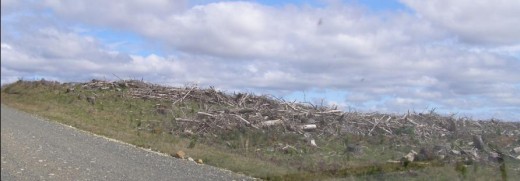 Tasmanian forest habitat obliterated
[Photo by editor of North West Tasmanian Forests from car, 20100510, free in public domain]
. Tasmanian forest habitat obliterated
[Photo by editor of North West Tasmanian Forests from car, 20100510, free in public domain]
.
Indeed, environmental problems are rarely cut and dried; they are often ambiguous. It is impossible to have a rule for every contingency. A wise person knows how and when to improvise and when to make an exception to the rules.
Wisdom is not something you can just learn from a book or a lecture; it takes experience, reflection and self-knowledge. But even wise workers will appear hopelessly stupid if rigid rules keep them from using their judgment.
Australia’s natural environment needs workers who are capable of deciding the right thing to do in different situations and we need workplaces that encourage employees to use their judgment when exceptional circumstances arise. This applies not just to those who work in protecting our natural assets, but more importantly to those who exploit these shrinking assets and the habitats they provide to increasingly threatened wildlife.
Indeed, no matter how much we invest in training, wisdom will remain the most important skill of all.
.
Successive Australian governments’ treatment of the Australian natural environment continues to be characterised by exploitation, destruction and ambivalence that it will remain resilient forever. Such an attitude is immature and unwise in every respect.
Australian Governments need the getting of wisdom.
 Giant Carved Owl in the Tree of Life at the Animal Kingdom, Disneyland.
Source: BeaDzyner’s photostream, http://www.flickr.com/photos/99642777@N00/379587620/ Giant Carved Owl in the Tree of Life at the Animal Kingdom, Disneyland.
Source: BeaDzyner’s photostream, http://www.flickr.com/photos/99642777@N00/379587620/
.
-end of article –
Saturday, February 19th, 2011
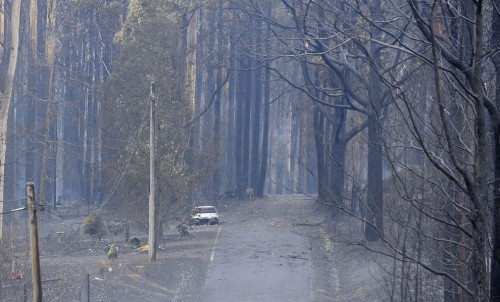
.
1. Purpose of Reform Initiative
.
This reform initiative proposes to standardise and make compulsory throughout the NSW Rural Fire Service the following requirements:
- To record the complete direct and indirect costs attributed to fighting and supporting the fighting of each registered bushfire event received and responded to by the NSW Rural Fire Service (RFS) across New South Wales.
- For each registered fire responded to by the RFS, the combined direct and indirect costs incurred by the RFS and all associated organisations are to be incorporated into the Total Fire Cost of each registered fire.
The purpose of capturing the Total Fire Cost of each registered fire is to establish and maintain a database of the Total Fire Cost for every received and registered fire by the NSW Rural Fire Service across New South Wales.
.
.
2. Recommended Policy
.
The Fire Control Centre of each Rural Fire District in New South Wales must establish and maintain a separate Fire Event Log of each registered fire occurring, either wholly or partially, within its Rural Fire District.
A minimum Australian standard of vital fire information necessary for a Fire Event Log must be established and approved by the NSW Rural Fire Service Commissioner. This standard must be reviewed annually ahead of each peak fire risk season.
A suitable training programme in Fire Event Log Procedures must be established to enable suitable fire personnel to be trained in order to competently maintain a Fire Event Log to the minimum Australian standard.
This policy should be integrated into the RURAL FIRE SERVICE Standard Operating Procedures once a process of consultation with all relevant personnel has been extensively undertaken across the entire breadth of the organisation.
Once approved, a Fire Event Log Policy and Procedures should be gazetted into the Rural Fires Act (NSW), 1997 and considered similarly for each fire authority in each Australian State.
.
.
3. Recommended Procedures
.
1. The Fire Control Centre of each Rural Fire District across New South Wales must establish a new and separate Fire Event Log upon becoming first aware of any fire within its fire district.
2. A Fire Event Log must be maintained continuously throughout the duration of a fire within a Fire District until such time as the responsible Fire Control Officer (or higher RURAL FIRE SERVICE command) declares the fire extinguished within that district.
3. A Fire Event Log must be recorded using the RURAL FIRE SERVICE central computer system, with appropriate daily data back ups generated at the end of each day.
4. The Fire Control Officer for a given Rural Fire District is ultimate responsibile and accountabile for establishing and maintaining an accurate and thorough Fire Event Log for each fire in its district. A Fire Control Officer may only delegate the task of maintaining a Fire Event Log to a qualified fire fighter holding a current endorsement in Fire Event Log Procedures.
5. The Fire Control Officer of each Rural Fire District must endeavour to capture all information about a fire in a separate Bushfire Event Log for each fire (where possible) including, but not limited to:
5.1. The designated name of the subject fire
5.2. Date & time of the ignition
5.3. Location of the ignition
5.4. Cause of the ignition
5.5. GIS digital map updating of the fire spread, likely path and key data
5.6. Details of the initial reporting of the fire outbreak/detection details
5.7. Lapse time to initial response & details of initial response action
5.8. Location of fire(s) & fire behaviour updates at 15 minute intervals
5.9. Local and forecast weather statistics relevant to the fire
5.10. Interstate agencies seconded
5.11. Daily updates on Total Area Burnt
5.12. Daily updates on any lives Lost
5.13. Daily updates on property lost, including number of dwellings
5.14. Daily updates on area of private property & farmland burnt
5.15. Daily updates on areas of mapped high conservation areas burnt
5.16. Daily updates on the number of fire-fighters involved
5.17. Daily updates on the number of aircraft involved
5.18. Daily synopsis on the fire(s) status
5.19. Executive decisions and actions taken, including incident declaration
5.20. Critical issues
5.21. Key operational threats & risks
5.22. Fire resource needs and shortfalls
5.23. Contact details and correspondence with assigned fire investigation
5.24. Total duration of fire activity once extinguished
5.25. Injury Summary Report
5.26. Resource Usage Summary Report by contribution agency
5.27. Register of Support Agency Involvement
6. When a fire takes the form of combined fires or multiple fire fronts within reasonable proximity in a geographic area, the responsible Fire Control Officer may order that a single Fire Event Log be maintained for the combined fires/multiple fire front.
7. Regular communication must be maintained between the Fire Control Centre and field brigades fighting a fire to facilitate logging fire activity to a minimum standard that allows communications at a minimum interval of 15 minutes.
8. Any communications failures or difficulties between firefighting crews (ground and airborne) and Fire Control, or any problems experienced in maintaining a minimum 15 minute communications frequency, must be immediately reported by the Fire Control Officer, or in the case of a major fire incident, to the Incident Controller.
9. A Fire Event Log is to be deemed the official single register of a fire event, a core operational document and a legal document admissible in a court of law.
10. As an internal document, a Fire Event Log is not automatically available for public access. The RURAL FIRE SERVICE Commissioner may at his/her discretion allow public access to such a document via a Freedom of Information Request from a member of the public.
11. The integrity and security of a Fire Event Log is paramount and is the ultimate responsibility of the Fire Control Officer assigned to a given fire. A digital copy of Fire Event Log must be provided by a Rural Fire District branch to RURAL FIRE SERVICE Headquarters within 7 days of the fire being declared extinguished. A secure and accessible database of Fire Event Logs is to be maintained by both the respective Rural Fire District branch and for all fires across NSW by RURAL FIRE SERVICE Headquarters.
 Koala burnt in Victorian Bushfires of February 2009
© Photo by Rebecca Hallas
[Source :http://www.watoday.com.au/national/physical-scars-will-remain-20090211-83u7.html ]
.
. Koala burnt in Victorian Bushfires of February 2009
© Photo by Rebecca Hallas
[Source :http://www.watoday.com.au/national/physical-scars-will-remain-20090211-83u7.html ]
.
.
.
4. Justifications for Reform Initiative
1. While it is acknowledged that the author is not a member of the Rural Fire Service and so privy to existing Rural Fire Service policy and procedures for recording bushfire operations, the lack of operational detail provided the Section 44 Incident Controllers Report for the Nov-06 Grose bushfire and the absence of minutes from the subsequent Inter-Agency review on 19-Dec-06, highlight shortcomings in record keeping of fire operations.
2. Perhaps much of the information reported of bushfire events is obtained from personal recollection of events from individual line personnel a considerable time after the event. For instance, the Section 44 Report into the Grose bushfire (14-Nov-06 to 3-Dec-06) is dated 8-Feb-07, two months later. There are obvious problems relying upon recollecting detailed events, the precise time and order of those events, the changing fire behaviour, the decisions made and actions taken and the changing conditions at the time. The absence of a factual minute by minute event log makes it difficult to be accurate and comprehensive in reporting major bushfire incidents. In the event of a major fire, maintaining a Fire Event Log will provide a record the performance of the four ICS functions – control, operations, planning and logistics.
3. It may well be that bushfire agencies in each Australian state have their own methods and protocols for recording fire events. It may also be that different agencies and indeed different regional branches have their own different ways of recording bushfire event data. There is likely no universal consistent standard across Australia of recording bushfire events as they occur. Some records may be better than others. There is a need to have a consistently high standard of record keeping for bushfire events across Australia.
4. Recent coronial inquests in Australia into bushfire deaths (Canberra Bushfire Jan 2003, Eyre Peninsula Fire Jan 2005), highlight the need for fire authorities need to have accurate records of bushfire events so that they are better able to defend their actions in court.
.
.
5. Benefits of Reform Initiative
.
1. The benefits of establishing and maintaining a Bushfire Event Log is to better enable bushfire management to achieve an accurate and comprehensive record of a fire – the events, decisions and actions and outcomes associated with each fire event. All relevant operational data associated with a fire will be recorded in one convenient document.
2. A Bushfire Event Log will provide a reliable source document for preparing a fire incident report. This will avoid the often difficult task of having to recall events, the order of those events, decisions made along with the fire behaviour at the time, long after a fire sometimes days or weeks later when memories have faded.
3. Recent reports and inquests have highlighted failures in fire-fighting communications, which arguably had a role in contributing to operational problems in controlling the spread, severity and impacts of fires. Compulsorily requiring a Bushfire Event Log will require regular communication between fire-fighters and Fire Control. This requirement will help drive the need to improve the reliability of operational communications during a bushfire event.
4. A Bushfire Event Log will provide a actual live record of the performance of the co-ordination, command and control functions of the ICS, including the operational sequence: Reaction, Reconnaissance, Appreciation, Plan, Issue of Orders and Deployment. This log will be highly useful at a debriefing session following a fire, allowing operational problems to be better identified. This will aid the RURAL FIRE SERVICE to increases its knowledge and understanding of rural fire fighting.
5. A Bushfire Event Log will enable bushfire management to be more transparent in reporting its operations, assisting any possible coronial investigations, for operational evaluation and improvement, analysis and to contribute firefighting practice into bushfire research. By making fire event logging compulsory, regular information must be fed back to central command in order to achieve the minimum reporting standard. This will drive a higher standard in strategic communications.
 Property incinerated in Kinglake Fire 7th February 2009.
Source: http://www.life.com/image/84754030 Property incinerated in Kinglake Fire 7th February 2009.
Source: http://www.life.com/image/84754030
.
– End of article –
Wednesday, February 16th, 2011
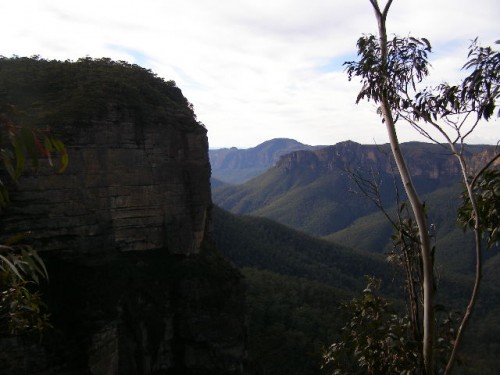 Grose Valley in the Blue Mountains World Heritage Area
..owes its initial salvation to legendary trail blazers Alan Rigby, Myles Dunphy and others of the Sydney Bushwalkers Club in 1931,
who saved the Blue Gum Forest from the threats from farming destruction.
[Photo by Editor 20060625, free in public domain]
. Grose Valley in the Blue Mountains World Heritage Area
..owes its initial salvation to legendary trail blazers Alan Rigby, Myles Dunphy and others of the Sydney Bushwalkers Club in 1931,
who saved the Blue Gum Forest from the threats from farming destruction.
[Photo by Editor 20060625, free in public domain]
.
“We cannot really live for commerce alone, nor will our civilisation be deemed great until we thoroughly recognise the fact that the bushlands and all they naturally contain are gifts of Nature far transcending in value all monetary and commercial considerations.
The humanising gifts of Nature are necessary for our interest, education, adventure, romance and peace of mind.
They constitute the antidote for the evils of our semi-artificial existence. As we destroy our bushland environment we destroy just so much of ourselves. The balance of Nature is finely adjusted: upset it, and there will be a desert at our doors.
All the glory of the canyons, caves and rolling plateau of our great Blue Mountains is not nearly so much a commercial asset as it is Nature’s heritage for legitimate enjoyment, and our own gift to prosperity.”
[Myles J. Dunphy, The Katoomba Daily, Friday 24th August, 1934].
.
Back on Saturday 28th May 2005, the editor was privileged to participate in a special day to farewell Myles Dunphy’s son, Milo Dunphy. Made welcome by the Dunphy family and close friends, I shared a special trek into the outer Blue Mountains wilderness and celebrate scattering the ashes of Milo Dunphy back into his wilderness home of the Blue Mountains.
Despite being blown by chilling winds and under a big blue Australian sky, our dedicated group persisted along a remote, little known foot track up to Kanangra Tops. For Milo the man and the legacy, we arrived in pristine wilderness as far as the eye could see, all thanks to Milo’s life campaign to protect it.
Milo Dunphy lead an environmental cause since the 1960s, saving Colong Caves, the Kanangra, the Komung, the Boyd, the Grose. Milo was the catalyst for what we are all now thankfully able to appreciate from the many trails and lookouts throughout The Greater Blue Mountains World Heritage Area. The legacies of the life works of Myles Dunphy and his son Milo deserve recognition and celebration.
Friday, February 4th, 2011
The local Blue Mountains Gazette newspaper of the Blue Mountains (west of Sydney) yesterday reported the harming of wildlife in the Blue Mountains National Park (read below).
.
$100 REWARD
Disgusted at this wildlife crime, the editor is offering a one-off reward of $100
for the identification of the offender(s) responsible for this wildlife bashing
and its reporting to the National Parks and Wildlife office at Blackheath, which secures a conviction.
.
Contact the editor : info@habitatadvocate.com.au
.
.
‘Snake bludgeoned at Blackheath‘
by Krystyna Pollard (journalist), 20110202, page 11.
.
‘National parks officers have condemned the brutal bludgeoning of a female (eastern) brown snake carrying 19 eggs at Blackheath’s Evans Lookout.
The snake was found on January 13 by a member of the public in her nest alive but with a broken back, according to National Parks and Wildlife Service (NPWS) ranger Vanessa Richardson.
“This brown snake had lived in the vicinity of Evans Lookout for over five years and lived harmoniously with many visitors who appreciated observing her in the natural environment,” she said in a statement.
“She was well known to NPWS staff and many tour operators enjoyed taking visitors to the site to see a real Australian snake in the wild.”
The snake was taken for treatment, however vets were unable to save her, Vanessa said.
“She was carrying 19 eggs, which were taken to a licensed reptile carer but unfortunately the eggs have collapsed and all eggs have failed,” she said.
“The end result of this is not the death of one brown snake but 20.
“The event has saddened local NPWS staff and wildlife carers and I would urge anyone with information on who may have harmed the snake to come forward.”
While snakes were not as popular with the community as other native wildlife, the NPWS reminded people that all native animals in NSW were protected and each had an important role to play in the ecosystem, Vanessa said.
“I understand if some members of the community are concerned by snakes if they happen upon them inside their homes,” she said.
“However in their natural environment they are overwhelmingly docile unless provoked. In fact most people that get bitten by snakes do so when trying to catch them, annoy them or kill them.
“Snakes preserve their venom to kill prey not people. If you leave them alone it is extremely unlikely they will do you any harm.”
Those caught harming wildlife face on-the-spot fines of up to $500. Higher penalties can be imposed by courts.
Anyone with information about the attack should contact the NPWS Blackheath office on 4787-8877.’
.
.
Comment:
.
This is a deplorable crime against wildlife in native and protected habitat. All flora and fauna in National Parks are protected from harm or disturbance.
In New South Wales under the National Parks and Wildlife Act (1974) Section 98(2), it is unlawful to harm protected fauna. Do do so attracts 100 penalty units and/or a6 month custodial sentence.
As at 7th December 2010, under the Crimes (Setencing Procedure) Act 1999 Section 17, this fine equates to $11,000 (100 penalty units multiplied by $110).
Hopefully, witnesses will come forward so that the perpetrators may be brought to justice, charged and convicted.
The introduced settler culture of Australia’s colonial history, ignorantly perceived Australian wildlife as vermin. The Australian bush and its native flora and fauna, rather than being respected, have long been detested by new arrivals. Such has been the immature misunderstanding due to ignorance. The abnormal fear of snakes (‘ophidiophobia‘) has been at the extreme. Henry Lawson’s 1892 short story ‘The Drover’s Wife’ most famously fueled this cultural fear as he described the snake in the story as having “an evil pair of small, bright bead-like eyes“, as “the enemy” and as the ..”original curse in common with mankind.”
In 2011 in national parks, most of us have surely developed a healthy respect for wildlife and its existence rights. As wildlife habitat shrinks and comes under increasing human threat, is it not humans whom are nature’s vermin?
.
Australia’s Eastern Brown Snake tends to inhabit grasslands and Dry Scheropyll forests situated in dry locations especially with rocky outcrops.
“It is a highly nervous, swift moving and alert snake which usually prefers to prevent confrontations with home owners. It is very quick to flee when seen or threatened but when cornered or attacked can be an explosive snake which will repeatedly lunge and defend vigorously.”
It’s diet is preference to lizards, frogs, other snakes, bird nestlings and baby rabbits, and small rodents such as rats and is therefore valuable in controlling pest species. Mating occurs in October to late Spring females oviduucal eggs are seen in late November to December.
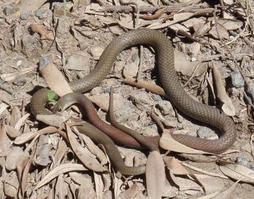 Eastern Brown Snake
Cresent Head NSW
© Photo by ‘Bev’
http://habitatnetwork.org/PhotoPages/Member-and-AnimalPhotos.htm#E
. Eastern Brown Snake
Cresent Head NSW
© Photo by ‘Bev’
http://habitatnetwork.org/PhotoPages/Member-and-AnimalPhotos.htm#E
.
References:
.
[1] Blue Mountains Gazette, p.11, ‘ Snake Bludgeoned at Blackheath‘, by Krystyna Pollard, http://www.bluemountainsgazette.com.au/news/local/news/general/snake-bludgeoned-at-blackheath/2064355.aspx
[2] Snake Handler.com.au, http://www.snakehandler.com.au/?pid=main&p=30
[3] HabitatNetwork.org http://habitatnetwork.org/PhotoPages/Member-and-AnimalPhotos.htm#E
[3] National Parks and Wildlife Act 1974, Specific Penalties and Orders, Judicial Commission of NSW, http://www.judcom.nsw.gov.au/publications/benchbks/local/National_Parks_and_Wildlife_Act.html
[4] CRIMES (SENTENCING PROCEDURE) ACT 1999, Section 17 ‘Penalty Units’, http://www.austlii.edu.au/au/legis/nsw/consol_act/cpa1999278/
.
Thursday, February 3rd, 2011
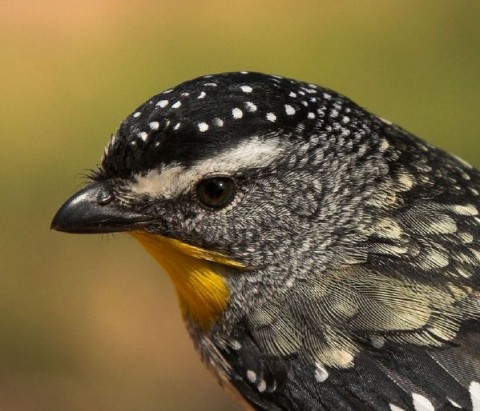 Spotted-Pardalote (Pardalotus punctatus)
© Photo by Julian Robinson
http://www.ozanimals.com/Bird/Spotted-Pardalote/Pardalotus/punctatus.html Spotted-Pardalote (Pardalotus punctatus)
© Photo by Julian Robinson
http://www.ozanimals.com/Bird/Spotted-Pardalote/Pardalotus/punctatus.html
.
.
Ben Esgate [1914-2003] from an interview in October 2002 [Jim Smith PhD]:
.
“Birds and everything like that are getting scarcer.
I reckon that since I have grown up, the bird life on the Blue Mountains has receded by 80%.
Too many bushfires destroy the breeding grounds of many birds, particularly Kookaburras and birds that use hollows. Clearing of land unnecessarily, and always killing the big trees, not the little ones. The big ones make the nests of tomorrow. In the smaller bird line, feral cats are causing no end of trouble. Pardalotes and all that sort haven’t got a chance, anything that builds a nest low in the trees.
Burning off National Parks, and areas adjacent to National Parks, just because the mob squealed because they have gone a built a house near the National Park, and now you have to keep fire from getting it.
The first things that happens then is that you have got to keep burning off around where people live…It might only destroy a bit in this place and a bit in that place, but it is still destroying things.”
“I reckon that I shot every third fox that I ever saw, never mind the ones I went hunting for, in my life. One in every three bit the dust and I’ve shot dozens and dozens and dozens of them. That meant that, including the offspring, there were several hundred foxes less to feed on our native wild life and wipe them out.
I saw them wipe our Rock Wallabies out in the Megalong completely…I shot foxes for many years, right up until I was 80.
I was knocking over 20 a winter up there (Galong Bluffs), when I was 79.
I never shot in a National Park. They knew up there, the National Parks mob, they knew I was knocking them off and they thought it was wonderful.”
.
.
Further Reading:
.
[1] http://www.survival.org.au/birds_spotted_pardalote.php
[2] Blue Mountains Bird List, by Carole Proberts, http://www.bmbirding.com.au/bmlist07.pdf
[3] ‘ The last of the Cox’s River men : Ben Esgate 1914-2003‘ / by Jim Smith, ( NLA).
.
– end of article –
Tags: Ben Esgate, bird life, Blue Mountains wildlife, burning off, bushfires, feral cats, foxes, getting scarcer, hazard reduction, Jim Smith, Kookaburras, Megalong, Pardalote, Rock Wallabies, tree hollows
Posted in 07 Habitat Conservation!, 34 Wildlife Conservation!, Birds (Australian), Blue Mountains (AU), Threats from Bushfire, Threats from Poaching and Poisoning | No Comments »
Add this post to Del.icio.us - Digg
|
|
 Gandalf, The Lord of the Rings
Gandalf, The Lord of the Rings
 Tasmanian forest habitat obliterated
[Photo by editor of North West Tasmanian Forests from car, 20100510, free in public domain]
.
Tasmanian forest habitat obliterated
[Photo by editor of North West Tasmanian Forests from car, 20100510, free in public domain]
. Giant Carved Owl in the Tree of Life at the Animal Kingdom, Disneyland.
Source: BeaDzyner’s photostream, http://www.flickr.com/photos/99642777@N00/379587620/
Giant Carved Owl in the Tree of Life at the Animal Kingdom, Disneyland.
Source: BeaDzyner’s photostream, http://www.flickr.com/photos/99642777@N00/379587620/















